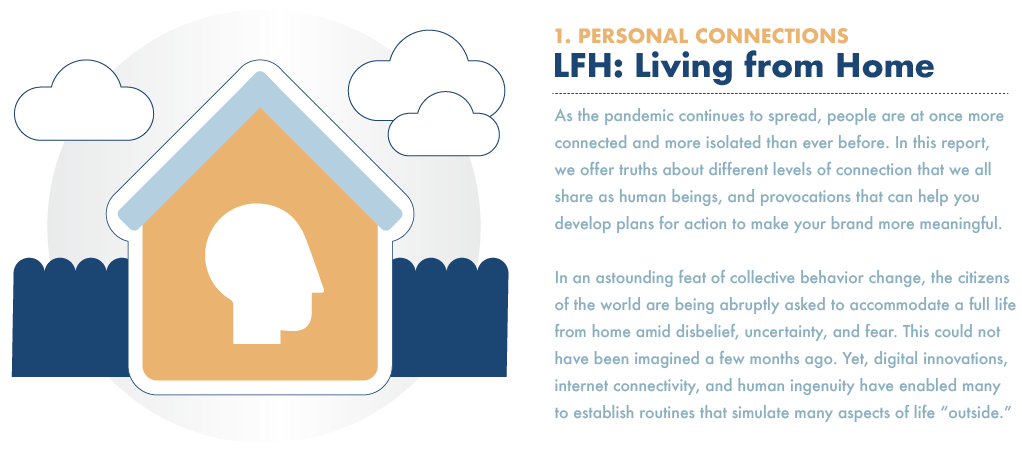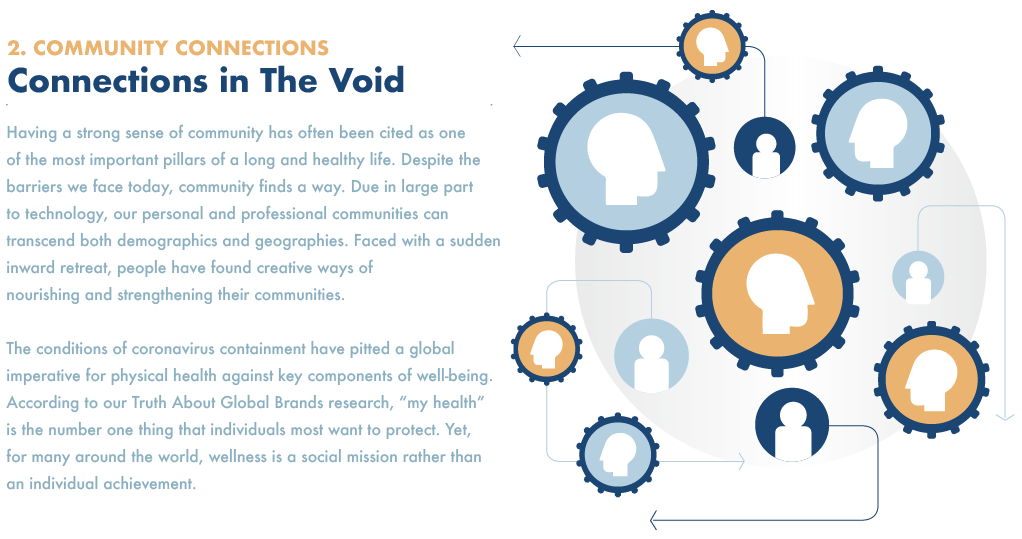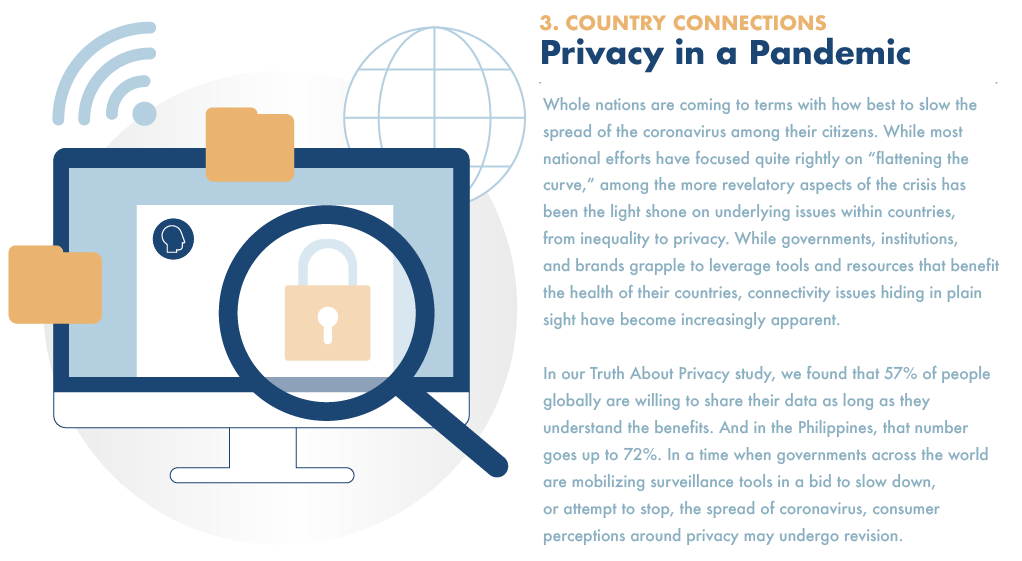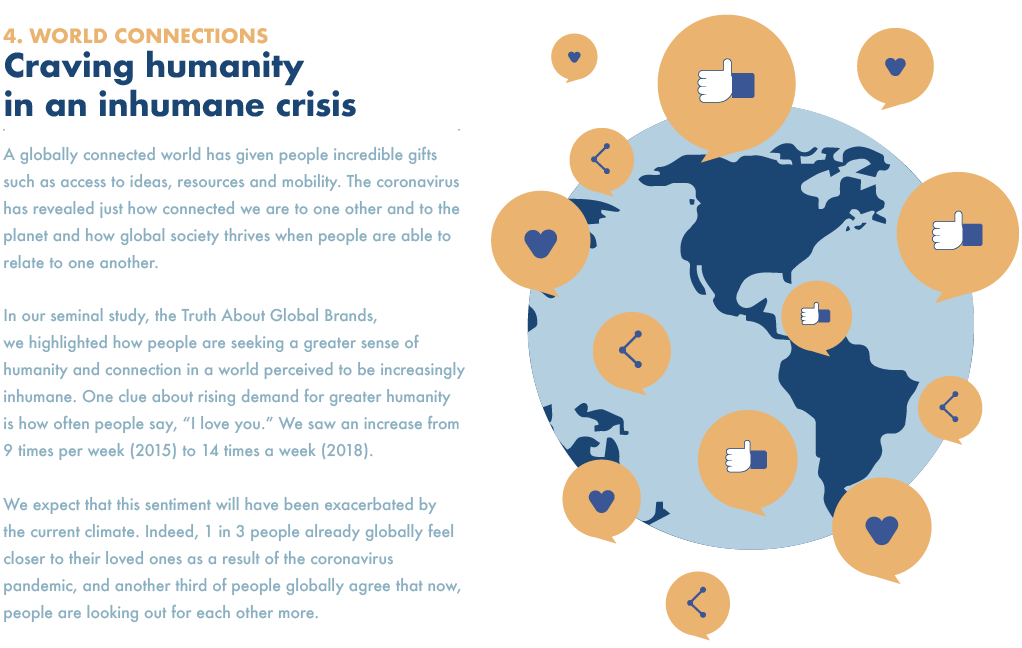A Brand’s Role To Strengthen Human Relationships
“Social distancing” and “self-isolation”—once novelties, are now defining phrases of everyday life in 2020. However, if this pandemic has taught us anything so far, it’s that the human need for connection is impossible to silence. From more frequent check-ins with our families, friends, and work husband/wives; to the agile creation of virtual global dance parties, live-streamed group yoga classes, and parenting chat groups, the quest for meaningful connection is resulting in infinite permutations of creative adaptation.

Suddenly, the world’s cultural spaces are more accessible to more people around the world. Museums are opening their doors and unleashing their famous collections, symphonies and theaters are offering access to performances. In a sense, these offerings are enabling many to connect to new, or favorite, settings that would be otherwise off- limits – and in some cases, physically inaccessible even in the pre-COVID world.
Meanwhile, hundreds of thousands of people are building muscle memory for new ways of working from home: learning everything from how to look good via webcam to running a virtual workshop on Microsoft Teams. From avoiding the commute to having lunch with loved ones, WFH brings certain benefits that are becoming apparent.
However, as the novelty of amusing Zoom backgrounds is replaced with persistent backache, people will run into new challenges. As technological connectivity is turbo-charged across sectors, big issues like privacy and technology regulation are being impacted.
As more people turn inward, there will be fewer opportunities for spontaneous connection with the shallow local networks that make for good living. The comfort of being in the presence of others may be replaced by a greater comfort with absence. Instead of asking, “Is there a reason to do this online?”, we’re now asking “how much of my old life can I successfully fulfill virtually?”
Provocation: How can your brand help people to re-establish a sense of connection among those isolating at home? In which moments can your brand show up in their lives now that people have limited contact with the outside world?

Transferring social wellness into confined and cordoned spaces has given rise to a host of innovative workarounds for enabling social interaction. From everyday joys to major life milestones, shared experiences are being reimagined for a world operating behind screens and closed doors.
Gen Z communities, for instance, have been particularly creative in how they’ve adapted to these quarantine times. Students all around the world haven’t let school closures dampen their excitement to graduate. Elementary school students in Japan recreated their auditorium in Minecraft to host their own celebration, complete with a stage and ample seating.
For those who are not used to online communities, quarantine conditions have resulted in a growing sense of isolation that many organizations are racing to rectify. While digitally socialized, an offline grassroots community initiative was launched in the UK to assist the socially isolated either by running errands or simply picking up the phone for a call, particularly important in a country where there is an official Minister of Loneliness. In the Philippines, online communities have transformed to become sources of offline support. Ordinary citizens have taken to using social and messaging platforms as ways to disseminate timely information and provide practical help to fellow citizens coping with COVID 19.
Embracing technology as a conduit for community connection has been years in the making. Last year, 77% of people globally agreed that to be connected to someone or something today requires technology, a figure that’s sure to have risen since the outbreak. Outside of the workplace, video-conferencing platforms have quickly become go-to forums for hosting events. And, on Douyin, the Chinese version of TikTok, nightclubs have started hosting “cloud raves” so people can tune in to live DJ sets and interact with other attendees like at the Singapore-based nightclub, Zouk.
Provocation: As people look to replicate beloved offline experiences, how can your brands help facilitate and ease the transition to a digital-first means of connecting? Which platforms are you leveraging in order to help foster a stronger sense of connection – with others and with your brand?

Our Truth About Privacy research revealed a privacy gap between countries such as the U.S. and China. In China, a clear tradeoff of personal privacy for technological advances or safety is valued, whereas in the U.S., Americans would forego the tech for privacy. In South Korea, the government utilizes mobile phone data, credit card records, CCTV footage, and public transport cards to track and publicize the activities and movements of confirmed coronavirus patients. In Hong Kong, where there has been a surge of cases due to inbound travelers, the government responded by putting electronic GPS-tracking wristbands on arriving passengers to enforce a mandatory 14-day home quarantine.
In the Philippines, we have seen citizens have become more willing to share their personal information either to air complaints online, or to ask for help from other netizens. And as our quarantine status continues to fluctuate, so does what seems acceptable to share. Videos of people that seemingly go against latest community quarantine rules continue to become daily fodder in group chats and on social media.
While many of these efforts use data in ways that will save lives, there are emergent threats. As a respondent in Japan said, “I’m concerned that once I became infected, my personal information would be exposed as if I was a criminal.”
Provocation:
Are you using the data people exchange for your brand’s services in ways that go beyond optimizing media targeting? What are you doing with the data you collect in order for consumers to feel that the value exchange is worth it?

Many responses to the pandemic are relatively universal. Stuck at home? Deep cleaning seems to be top-of-mind across the world with Google searches for “cleaning” registering the highest number of searches to date. All alone? Time to adopt a pet – an action that has driven unprecedented demand at New York shelters!
In many countries, people are applauding for healthcare workers daily. Cities ring with the sound of infinite gratitude and remind citizens that they are all in this together. In France, geopolitics reporter Annabelle Timsit described taking to the street every day at 8pm to applaud healthcare workers with crowds of fellow Parisians. And in the Philippines, we have seen an outpouring of gratitude towards doctors, nurses, and other healthcare professionals on almost a daily basis.
The U.K. national health service saw 500,000 volunteers registering in less than 48 hours and there are countless neighborhood groups popping up to serve the vulnerable or those most in need. As one respondent in the US told us, “we will face the fear this virus is causing and work together, reconnecting to each other globally, to find solutions, to support each other, to grow, to heal together as one humanity.” Last year, we found that 29% of people globally had volunteered in their community in the past 12 months, a figure that is likely to reach new heights in the current crisis. Similar efforts in other countries have produced staggering amounts of compassion such as a Portuguese app that was designed in 3 days to help connect people in need to those who can volunteer.
Implication: We know from our Truth about Global Brands research that brands have permission to play a truly human role in the lives of consumers. As people actively seek a greater humanity, how can your brand reflect this and show a deeper sense of empathy?
ALLOW US TO HELP YOU CONNECT THE DOTS
As the pandemic progresses, so does our reassessment of how we nurture our connections as innately social beings. And the ever dynamic way people are responding to COVID 19 around the world opens up new opportunities for brands to earn their place in consumers’ lives. If you would like to go deeper into any of these themes and explore what the implications are for your business, please get in touch with our Strategy Director, Earl Javier at [email protected]


